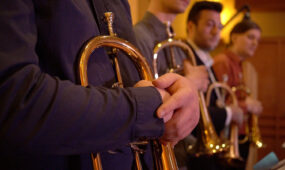State Opera’s Tosca is a triumph
Music
Fuelled by drama, tragedy and beauty, this new production of Tosca begins with action and doesn’t cease its momentum until the dying notes, writes Greg Elliott.

Giacomo Puccini’s Tosca, originally performed in 1900, is set in 1800, a turbulent time when royalists were in fear of the rise of republicanism and religious orders were concerned about Voltaire and others writing about the rights of man. The animosity between the opposing groups led to violence and executions.
Conductor Nicholas Braithwaite and the superb Adelaide Symphony Orchestra launched us into this spell-binding experience with some dramatic chords to accompany Jeremy Tatchell’s entrance as the prison escapee, Cesare Angelotti.
The State Opera show begins with action and doesn’t cease its momentum until the dying notes. Everything about this production is impressive: designer Ashley Martin-Davis’s sets are majestic and beautiful, the principals are world-class, the chorus is tremendous and the orchestra is brilliant.
Tosca tells the story of real people, and their story is every bit as relevant to world events today.
Rosario La Spina plays Mario Cavaradossi, an artist in favour of the republic but who finds himself, ironically, painting the Madonna in the church of Sant’Andrea della Valle. When La Spina first sang, the audience gasped with joy and delight; his voice fills the theatre and his presence brings a reality and belief to the role.
How wonderful it is to have Kate Ladner return to Adelaide to sing the role of Tosca. In the opening scene, she looks beautiful in a soft pink dress, representing the purity of Tosca, and she radiates the seductive charm of the woman renowned for her singing.
La Spina and Ladner’s powerful voices blend and reverberate through every individual. Their characters’ expressions of love feel heartfelt and Ladner’s witty little quips of jealous intent are welcome comic relief.
Mario Bellanova is Baron Scarpia, the official dedicated to hunting down Angelotti and his accomplices and who, in Act Two, offers Tosca’s freedom if she agrees to his sexual advances (although, even more odiously, he brags about how he prefers it if she doesn’t enjoy the act). Scarpia is the villain that audiences love to hate, and Bellanova appears to revel in performing the role.
Act One finishes with almost the entire cast on stage, and the exceptionally explosive “Te Deum” leaves the audience enthralled and wanting more.

Kate Ladner (Tosca), Rosario La Spina (Cavaradossi), henchmen David Cox and Andrew Turner, and Mario Bellanova (Scarpia) in Act 2. Photo: Ali Feo
In Act 2, in Scarpia’s apartment, Ladner, dressed in a red gown which reflects Tosca’s being thrust into the reality of conflict, sings “Vissi d’arte” (“I have lived for art”), which is heart-breaking in its representation of the innocent victims of violent disputes. There were further audible gasps of appreciation from the audience in response to the beauty and sense of suffering conveyed.

Get InReview in your inbox – free each Saturday. Local arts and culture – covered.
Thanks for signing up to the InReview newsletter.
After being treated in a degrading and humiliating manner, Tosca decides on defiance rather than submission, which leads to further consequences.
The Third Act is picturesquely set on the roof of the Castel Sant’Angelo, with an imposing statue of the angel Michael, and briefly we enjoy the wonderful voice of Robert England as the jailer. La Spina brilliantly sings the aria “E lucevan le stelle”, and the drama does not quite unfold as Tosca had assumed.
Tosca is an opera and narrative of great drama, power and beauty, and the State Opera’s production is a musical and aesthetic triumph.
State Opera SA will present Tosca again at the Festival Theatre on November 15, 17 and 19.
Support local arts journalism
Your support will help us continue the important work of InReview in publishing free professional journalism that celebrates, interrogates and amplifies arts and culture in South Australia.
Donate Here





Comments
Show comments Hide comments